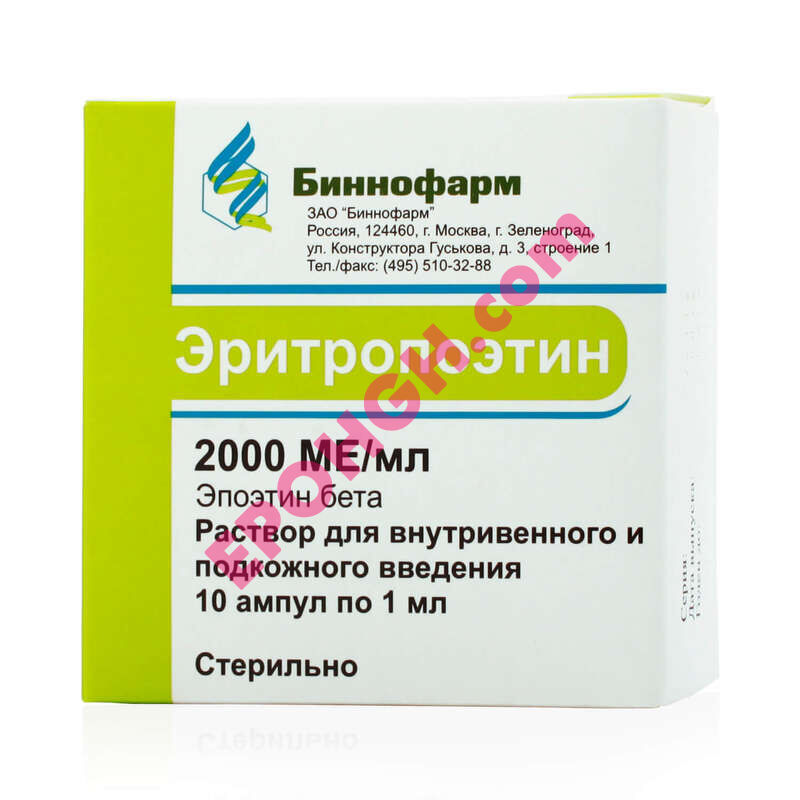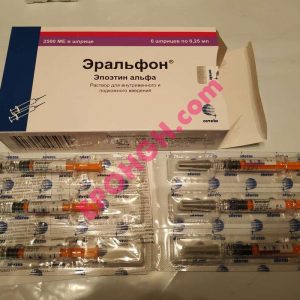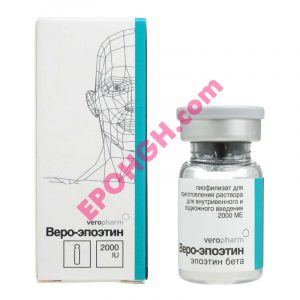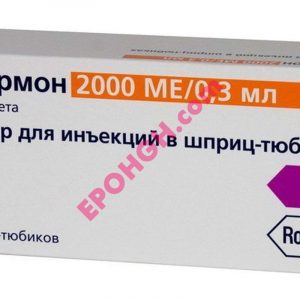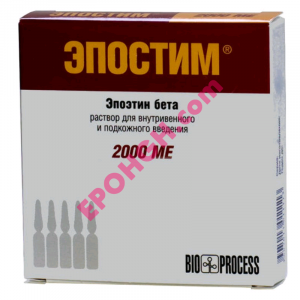$190.00
Description
Lyophilisate for the preparation of solution for subcutaneous administration, solution for intravenous and subcutaneous administration, lyophilisate for the preparation of solution for intravenous and subcutaneous administration
An erythropoiesis-stimulating agent, a glycoprotein, which is a mitosis-stimulating factor, and a differentiation hormone that promotes the formation of erythrocytes from stem cells. It increases the number of erythrocytes, reticulocytes, hematocrit and Hb in the blood, as well as the rate of incorporation of Fe in the cells. Specifically affects erythropoiesis, does not affect leukopoiesis.
In chronic leukocytic leukemia, response to epoetin beta therapy occurs 2 weeks later than in patients with multiple myeloma, non-Hodgkin's lymphomas, and solid tumors.
Prevention and treatment of anemia of various origins: anemia in chronic renal failure (including in hemodialysis patients),
Anemia in patients with solid tumors receiving chemotherapy with Pt drugs (cisplatin 75 mg/m2 per cycle, carboplatin 350 mg/m2),
Anemia in adult patients with multiple myeloma and low-grade non-Hodgkin's lymphomas and chronic lymphocytic leukemia receiving cancer treatment, with a relative deficiency of endogenous erythropoietin (defined as disproportionately low in relation to the degree of anemia, the concentration of erythropoietin in the blood serum).
Erythropoietin in sports.
Erythropoietin is widely used in sports. Their synthetic counterparts are used to give muscles the ability to do hard work for a long time. Drugs, therefore, that affect the athlete's body are called doping.
An athlete taking erythropoietin-based doping is able to run, cycle or row for a long time without feeling tired.In other words, this doping has found application in those sports that require a long and uniform effort. But for heavyweight athletes, it is not very suitable.
Athletes use the property of the drug to affect the oxygen content in the blood and, consequently, improve the nutrition of tissues.
First of all, erythropoietin is used in those sports, where aerobic endurance is important. These include running for medium and long distances in track and field, cycling, and cross-country skiing.
The payment for the ability to run or cycle for a long time is an accelerated metabolism and the burning of all reserves of iron, folic acid and other elements of the hematopoietic system.
Several deaths were reported, among cyclists alone, after which erythropoietin drugs were officially recognized as dangerous doping and banned from use. All athletes convicted of using erythropoietin were disqualified for the rest of their lives.
Erythropoietin doping is very difficult to determine from an athlete's blood or urine test. Therefore, since 1990 anti-doping laboratories have been developing methods to detect a prohibited drug in samples from athletes. Since the synthetic hormone, in its composition and action, is identical to the natural one, moreover, its presence in the blood is explained by the stressful situation caused by the competition, it is extremely difficult to detect it.
Therefore, it was decided to measure not the amount of the hormone in the athletes' blood, but the level of oxygen and hemoglobin. Although this measurement method is quite subjective, because someone was calm before the start, and the day before he rested, and someone entered for a long time and was very nervous.
Despite the controversy of the methods of determining the blood doping of an athlete, the conclusion regarding the use of a drug with erythropoietin can be made simple – the effect of it can be fatal.
But there is another opinion, which was born in the light of recent events related to sports competitions of world importance, namely the Olympic Games. The main thing for sports officials is not to identify an athlete using doping, but to remove athletes from competition with a policy that is wrong from their point of view. And few people in such a situation are interested in what effect the drug creates on a person.

